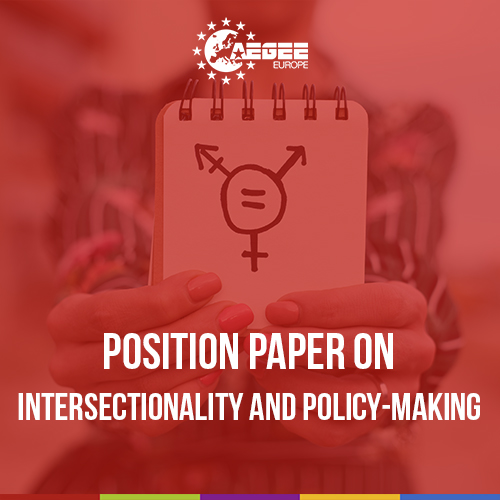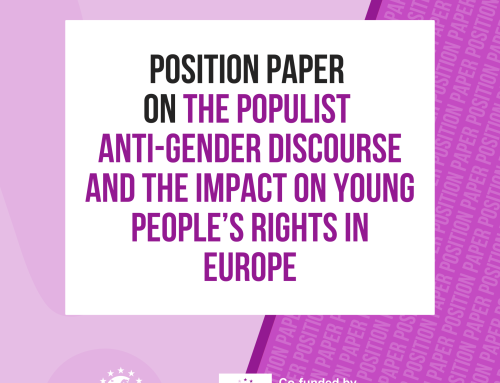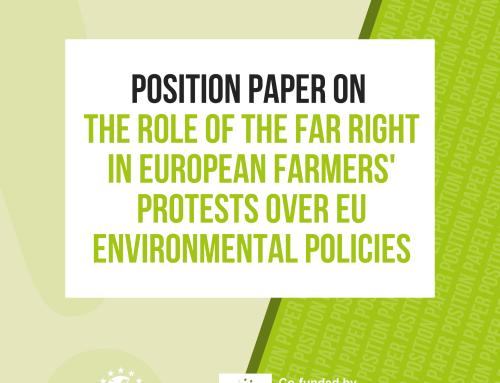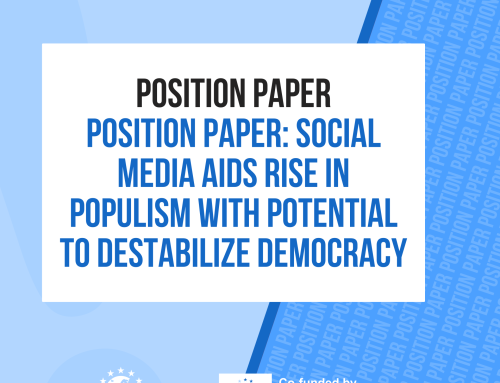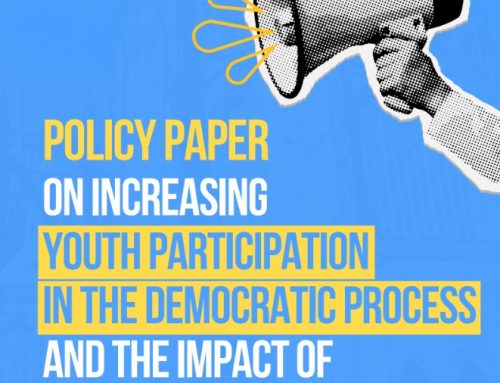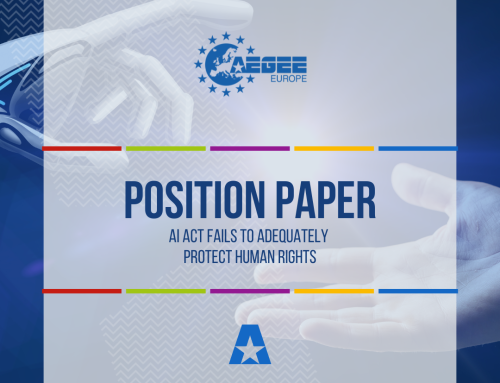Intersectionality and Policy-making
For an intersectional approach to youth policy and anti-discrimination law
Written by Juliette Beaulaton
Introduction
AEGEE (Association des Etats Généraux des Etudiants de l’Europe/European Students’ Forum) was created in 1985 with the vision of creating a unified Europe, based on democracy and a respect for human rights, by bringing together students with different cultural backgrounds. Today, AEGEE / European Students’ Forum is a non-governmental, politically independent, and non-profit student organization, which has around 13,000 members from 160 cities and 40 countries all over Europe. We strive for a democratic, diverse and borderless Europe, which is socially, economically and politically integrated and values the participation of young people in its construction and development. Our main mission is to strengthen mutual understanding among young Europeans and bring Europe closer by empowering them to take an active role in the society. In Autumn 2016, AEGEE established “Equal Rights” as one of its main thematic focuses for the upcoming three years. This Focus Area aims at acknowledging and tackling discrimination based on gender identity, expression and sexual orientation and promoting equity from an intersectional perspective.
AEGEE-Europe believes that in order to protect all young people from discrimination and strive for substantive equality, policy makers need to adopt an intersectional approach at every stage of the policy-making process, including in the field of anti-discrimination law and youth policy.
The goal of Youth Policy is to “provide young people with opportunities and experiences that support their successful integration into society and be active and responsible members of their society, as well as agents of change”1. Moreover, in its Communication on the new EU Youth Strategy, the European Commission stressed that the strategy should “strive to improve the prospects of all young people regardless of their background or social status” and insist on the need to ensure that the EU youth policy is truly inclusive.2
1 Council of Europe (2015), Access of Young People from disadvantage neighbourhoods to social rights CM/Rec(2015)3, p26, available online: https://rm.coe.int/CoERMPublicCommonSearchServices/DisplayDCTMContent?documentId=090000168066671e
2 European Commission (2018), Engaging, Connecting and Empowering young people: a new EU Youth Strategy, COM(2018) 269, p4 https://ec.europa.eu/youth/sites/youth/files/youth_com_269_1_en_act_part1_v9.pdf
3 European Youth Forum (2016), Policy paper on Equality and non-discrimination, p4 https://www.youthforum.org/sites/default/files/2017-11/0099-16_Policy_Paper_Equality_Non-discrimination_FINAL2_0.pdf
It is our conviction that those goals cannot be reached without rethinking the way we make policies, starting by acknowledging that “youth” is not an homogeneous social category3 , but is composed of people with very different social identities – gender, ability, race, geography, economical background and else – that interact with each other to create complex and unique experiences that can make “one-size-fit-all” policies ineffective or even harmful. Moreover,
youth policy goals cannot be separated from a strong anti-discrimination legal framework equipped to protect young people.
This position paper makes a case for an intersectional approach to youth policy and anti-discrimination law. After defining key concepts, the paper will present the development of the research on intersectional discrimination and how current policies handle intersectional inequalities and discrimination, then put forth AEGEE-Europe’s position and key recommendations.
Definition
To clarify the position of AEGEE-Europe, certain concepts must be defined.
▪ Intersectionality
US legal scholar Kimberlé Crenshaw4 coined the term to reflect the complexity of the experience of violence and discrimination of Black women. Crenshaw showed that this experience could not be adequately captured using a ’single-axis’ framework based on race or sex alone. Instead, as in an actual crossroad or intersection – racism and sexism factor into Black women’s lives in ways that can only be captured by looking at the race and gender dimensions of those experiences together5. Since then, the intersectional approach is widely used as a framework which aims at exposing the interconnection between different identities such as gender, race, sexual orientation, class, (dis)ability, etc. in order to account for complex, lived experiences of discrimination,
4 Crenshaw, K. (1989) Demarginalizing the Intersection of Race and Sex: A Black Feminist Critique of Antidiscrimination Doctrine, Feminist Theory and Antiracist Politics
5 ENAR (2018), Intersectionality and policy-making on discrimination in the European Union, available online: http://www.enar-eu.org/Intersectionality-Why-EU-policy-makers-should-adopt-an-intersectional-approach
6 Fredman, S. (2016), Intersectional Discrimination in EU gender equality and non-discrimination law, Directorate-General for Justice and Consumers, p4
7 Fredman, ibid, p8
8 European Commission (2008), Proposal for a Council Directive on implementing the principle of equal treatment between persons irrespective of religion or belief, disability, age or sexual orientation, COM(2008)0426, available online: https://eur-lex.europa.eu/legal-content/EN/TXT/?uri=celex%3A52008PC0426
The central problem identified by the notion of intersectional discrimination then is how to render visible and properly remedy the wrongs of those who are multiply disadvantaged6.
▪ Equality
For the purpose of this position paper, we choose a substantive definition of the concept of Equality. As Sandra Fredman argues, a definition of equality as the principle that “likes should be treated alike” is not enough if we want to adopt an intersectional perspective. We therefore subscribe to Fredman’s definition incorporating four dimension (i) the need to redress disadvantage, (ii) the need to address stigma, stereotyping, prejudice and violence, (iii) the need to facilitate voice and participation; and (iv) the need to accommodate difference and change structures of discrimination7.
▪ Discrimination
The legal definition of discrimination should be clarified to ensure that there is a harmonized understanding of the scope – at least at European level. In the European Commission’s Proposal for an Equal Treatment Directive8, discrimination refers to:
“1.Direct discrimination – where one person is treated less favourably than another is, has been or would be treated in a comparable situation;
2.Indirect discrimination – where an apparently neutral provision, criterion or practice would put persons of a particular religion or belief, a particular disability, a particular age, a particular sexual orientation, or else, at a particular disadvantage compared with other persons, unless that provision, criterion or practice is objectively justified by a legitimate aim and the means of achieving that aim are appropriate and necessary and;
3.Harassment shall be deemed to be a form of discrimination within the meaning of paragraph 1, when unwanted conduct related to any grounds takes place with the purpose or effect of violating the dignity of a person and of creating an intimidating, hostile, degrading, humiliating or offensive environment. “
However, contrary to the scope proposed in the Directive proposal, the definition of discrimination should cover all forms of discrimination, irrespective of grounds, as explicitly outlined in Article 14 of the European Convention on Human Rights.
▪ Multiple and Intersectional discrimination
Discrimination on several ground can take different form. According to Sandra Fredman, there are three identifiable categories. Firstly, “sequential multiple discrimination” (or cumulative discrimination), which occurs when a person suffers from discrimination on different grounds on separate occasions. Secondly, “additive multiple discrimination” (thereafter referred to as multiple discrimination) which occurs when a person is discriminated against on the same occasion but in two different ways. Fredman gives the example of a gay woman who “might claim that she has been subject to harassment both because she is a woman and because she is gay. Such discrimination can be said to be ‘additive’, in that each type of discrimination can be proved independently”. Finally, Intersectional discrimination “does not simply consist in the addition of two sources of discrimination [and] the result is qualitatively different’, it creates a unique experience of discrimination that only occurs because the person concerned is at the intersection of different identity.9 Crenshaw uses the example of the discriminatory hiring practices of a company that discriminate against black women. Since the company can prove that it is hiring both black men and white women, at first sight it cannot be accused of sexism or racism. The experience of black women is therefore is qualitatively different and rendered invisible, therefore difficult to prove and address.10
9 Fredman, ibid, p10
10 Crenshaw K. (2015), Why intersectionality can’t wait, The Washington Post, available online: https://www.washingtonpost.com/news/in-theory/wp/2015/09/24/why-intersectionality-cant-wait/
This position paper will focus on intersectional discrimination.
Context
Over the past years, there has been a growing interest in how multiple and intersectional discrimination affects people’s lives, and therefore whether existing legal frameworks are equipped to pursue goals such as inclusion, equality or the fight against discrimination. Studies and surveys adopting an intersectional approach are beginning to shed light on these aspects of discrimination and gather data to support the development of new policy-making frameworks. Scholars have also engaged in a critical assessment of existing legal frameworks and identified the gaps when it comes to dealing with equality and discrimination.
While navigating through studies integrating an intersectional perspective, the most striking aspect is the considerable lack of relevant data collection. Most studies used by policy makers
still research mainly one social category at a time. The new European Commission’s Communication on the EU Youth Strategy post-2018 falls into this category. While it attempts at proposing some disaggregated data in its staff working documents – for instance with data based on age and gender – the Commission’s research does not take into consideration other identities possibly intersecting with age.11
11 European Commission (2018), Commission Staff Working Document accompanying the document Engaging, Connecting and Empowering young people: a new EU Youth Strategy, COM(2018) 269 final, available online: https://ec.europa.eu/youth/sites/youth/files/youth_swd_169_part_6_2_en_autre_document_travail_service_part6_v4.pdf
12 European Youth Forum (2014), Survey on “Youth and Multiple Discrimination in Europe”, available online: https://www.youthforum.org/sites/default/files/2017-12/Survey-on-Youth-and-Multiple-Discrimination%20(1).pdf
13 FRA (2011), EU-MIDIS Data in Focus Report 5: Multiple discrimination, available online : http://fra.europa.eu/en/publication/2011/eu-midis-data-focus-report-5-multiple-discrimination
14 EIGE, Gender Equality Index 2017, available online: https://eige.europa.eu/gender-equality-index/2015/domain/work
15 Nagy, A. (2015), Creating a platform for Romani women and girls: Making them heard and seen through education, Commission on the Status of Women (Fifty-ninth session), p. 5
16 Khan, T. (2018), Sexual health and LGBTI Muslims, Blog ILGA-Europe, available online: https://www.ilga-europe.org/blog/sexual-health-and-lgbti-muslims
17 FEANTSA (2017) Homeless in Europe, LGBTIG Homelessness, The Magazine of FEANTSA, available online: https://www.feantsa.org/download/fea-008-17-magazine_v33480239002912617830.pdf
There is however an increasing effort in Europe to study multiple and intersectional discrimination and to raise awareness among the civil society and policy makers. In November 2014, the European Youth Forum published the results of a survey on “Youth and Multiple Discrimination in Europe”12 in an attempt to foster further research in the field. The results suggest that multiple discrimination and intersectional discrimination play a strong role in young people’s lives. The results of the survey illustrate how policies focusing on a single issue can fail to reach parts of a targeted groups as the needs inside this group can vary greatly for those at the intersection between different identities.
Dedicated agencies and NGOs are pursuing the work on intersectional discrimination to gather more data and present concrete examples of how young people’s life can be affected. Examples include the 2010 European Union Agency for Fundamental Rights (FRA) Report on Multiple discrimination affecting Minorities in the EU. The report investigates the experience of ethnic minorities and integrates data on gender and age to highlight how being at the crossroad of these different identities change the way ethnic minorities experience discrimination. It notably concludes that “gender and age are strong predictors of discrimination for certain groups”13 taking for example the fact that young ethnic minority/immigrant men tend to report high levels of discriminatory treatment. Similarly, the European Institute for Gender Equality is now working on improving data collection and presenting data reflecting intersecting inequalities.14
The literature on intersectionality and testimonies also provides for very concrete examples of how intersectional discrimination affects young people and of the limits of certain policies. Examples range from the experience of young Roma women with education 15, access to sexual health for LGBTI Muslims16, or even the question of homelessness.17
Adequacy of current regulatory responses
With the increasing interest in multiple and intersectional discrimination, it is interesting to question the relevance of existing legislation to assess how those concept and concerns are taken into account in Europe. Some national18 and European19 administrations as well as equality bodies20 have started to research how to improve policies by integrating an intersectional approach. However, those initiatives focus mostly on gender equality policies, and are rarely translated into policies or measures21. While the intersectional perspective is increasingly used as a theoretical framework, its application to public policy progresses slowly.
18 Swedish Secretariat for Gender Research, Gender Mainstreaming with an intersectional perspective, available online: http://www.includegender.org/wp-content/uploads/2015/06/Gender-Mainstreaming-with-an-Intersectional-Perspective-pdf.pdf
19 Forest M., Platero R. (2008) Quality in Gender+ Equality Policies, Report analyzing Intersectionality in Gender Equality Policies for Spain and the EU, Institute for Human Sciences.
20 EQUINET (2016) innovating at the intersections, Equality bodies tackling intersectional discrimination, available online: http://www.equineteurope.org/IMG/pdf/equinet_perspective_2016_-_intersectionality_final_web.pdf
21 European Commission (2015) Strategic Engagement for gender Equality 2016-2019
22 Denstad F., Youth Policy Manual, How to develop a national youth strategy, Council of Europe publishing, 2009 available online: https://pjp-eu.coe.int/documents/1017981/7110707/YP_Manual_pub.pdf/7b17e1e6-e8b6-4041-902e-3b3ad0973c45 OR; Council of Europe and European Commission, Youth Policy Essentials, Council of Europe publishing, 2017
23 Fredman, S., 2016, Intersectional Discrimination in EU gender equality and non-discrimination law, Directorate-General for Justice and Consumers
24 Fredman, ibid, p64
In the field of youth policy, practices and legal frameworks still varies greatly from one European country to another. While it is therefore difficult to assess the attention that is being paid to multiple and intersectional discrimination at national and local level, roadmap and guidelines created at European level by European Institutions or by the Council of Europe, are already indicators of the way policy are designed. It is striking to see that there has not be any attempt to develop comprehensive guidelines or research on intersectionality and youth policy based on previously mentioned models dealing with gender equality.
Recent publications from the Council of Europe or the European Union still do not to take into consideration now established research on intersectionality and policy-making. The recently published EU Youth Strategy fails to recognize that the strategy it wishes to implement is not neutral and will therefore have different impact depending on which other social category young people belong to. Similarly, Youth policy manuals and guidelines do not address the need for comprehensive data collection that would reflect the various needs of the targeted population.22
Concerning anti-discrimination law, critical assessments of existing European framework have clearly identified “severe structural obstacles to intersectional claim”23. This situation leaves parts of the population unprotected against acts of discrimination. Fredman proposes an extensive analysis of Intersectional discrimination in EU gender equality and non-discrimination law, which identifies the main challenges, including the complete fragmentation of EU anti-discrimination law in different Directives with various scope and grounds24.
The European Commission attempted to address this problem by proposing in 2008 a new anti-discrimination directive know as the Equal Treatment Directive or Horizontal Directive which would expand protection against discrimination on the grounds of age, disability, religion or belief and sexual orientation, to the areas of social protection, healthcare, education, housing and access to goods and services. The legislative process has now been on stand-by
in the Council of the European Union for 10 years despite repetitive call from NGOs to continue the negotiations.
In 2007, the European Commission also took the initiative to publish a Report on Multiple Discrimination, highlighting good practices and presenting recommendation on how to best address this type of discrimination25. It is however unclear if the European Commission has followed up on those recommendations.
25 European Commission (2007) Tackling Multiple Discrimination, Practices, policies and laws, available online: http://ec.europa.eu/social/BlobServlet?docId=776&langId=en
26 The Convention on the Elimination of all Forms of Discrimination Against Women and the Convention of the Rights of Persons with Disabilities have been identified as relevant examples of the integration of an intersectional perspective.
27 Symington, A., (2004), ‘Intersectionality: A Tool For Gender And Economic Justice, Facts and Issues’, The Association for Women’s Rights in Development (AWID)
28 Hankivsky O., Cormier R., (2011), Intersectionality and Public Policy: Some Lessons from Existing Models, Political Research Quarterly, Vol. 64, No. 1
29 Hankivsky O., (2014), An intersectionality-based policy analysis framework: critical reflections on a methodology for advancing equity, International Journal for Equity in Health, Vol. 13, No. 119, available online: https://equityhealthj.biomedcentral.com/articles/10.1186/s12939-014-0119-x
There are examples of international conventions26 that do take into consideration an intersectional perspective, as well as concrete proposition from legal scholar on what could be the next steps to integrate this perspective into anti-discrimination laws and practices. It is also clear that European institutions are aware of the problem of intersectional discrimination considering past research, but this interest and those initiatives have not yet had an effect on policy making.
Position of AEGEE-Europe
AEGEE-Europe believes that young people’s identity depends on much more than just their age. It depends on their belonging to various social categories and on various factors that define their experiences and their needs. Considering young people as individuals solely defined by their age in youth policy and the fight against discrimination is no longer an option if policy makers want to achieve the ambitious goal set in their policies.
One basic idea of intersectionality is “that a person’s experiences with a multitude of factors, such as race, gender, ability, age and socio-economic location, can interact or intersect in ways that can either advantage or disadvantage the person’s well-being and development”27 and therefore also impact if and how they benefit from policies aiming at supporting their well-being and development.
To truly understand the experience of young people and create policies that protects them and gives them the opportunity to become active members of society, policy makers need to incorporate an intersectional approach at all stages of the policy-making process28. An intersectional approach offers the necessary tools to critically assess existing policies, understand the intersection of social categories and fight against complex mechanism of oppression and discrimination. Intersectionality encourages policy makers to examine established practices – such as the focus on singular identities or categories – and forces us to answer questions such as: how policy affects diverse population, who is targeted by existing legislation, what inequities and privileges are created by current policy responses and so on29.
Without concrete changes in policy-making frameworks, anti-discrimination laws and youth policies are failing to truly challenge oppressive and discriminatory structures or are even reinforcing those structures by designing policies benefiting to the most privileged. Youth policies and anti-discrimination laws complement each other in fostering structural change for new generation. It is therefore imperative that they are designed to reach all young people.
Recommendations
AEGEE-Europe recommends that:
▪ Relevant European and National authorities drastically improve qualitative and quantitative data collection to gather intersectional evidence. Evidence-based policy is at the core of the policy-making process and it is essential that policy-makers have access to disaggregated data on multiple and intersectional discriminations.
▪ Relevant authorities invest resources to enable research institutions to develop user-friendly methods to translate intersectionality theories into practical frameworks for policy makers and complement existing research on intersectionality and public policy.
▪ The European Commission continues the work started in 2007 in its Report on Tackling Multiple Discrimination30 and follows up on the its recommendations.
30 European Commission (2007) Tackling Multiple Discrimination, Practices, policies and laws, available online: http://ec.europa.eu/social/BlobServlet?docId=776&langId=en
▪ The European Commission develop common guidelines and good practices on the adoption of an intersectional approach in policy-making.
▪ European Member States urgently adopt the Equal Treatment Directive to make the first step toward harmonizing anti-discrimination law in the EU
▪ Governments commit to work on anti-discrimination legislation that include all forms of discrimination, irrespective of grounds, as explicitly outlined in Article 14 of the European Convention on Human Rights, as well as guidelines outlining methods to ensure that cases of multiple and intersectional discrimination are better handled.
▪ The European Union and the Council of Europe continue to fund projects empowering youth organisation to work on discrimination, following the example of the Council of Europe’s Priorities for the 2018-2019 programme of activities that integrated Multiple discrimination and intersectionality as one of its priority.
▪ National and European policy-makers involve youth organisations in the development, implementation, monitoring and evaluation of youth and anti-discrimination policy and ensure that consultation processes are both targeted and accessible to more marginalized populations.
▪ National authorities provide the necessary resources and build the capacity of equality bodies in addressing multiple discrimination.
▪ Equality bodies continue to develop and share knowledge and good practices to advocate efficiently for the adoption of an intersectional perspective.
▪ Youth organisations develop or use existing guidelines to adopt an intersectional approach in the running of the organisation, the allocation of resources and the development of projects.
▪ Youth organisations raise awareness and educate their members on the concept of intersectionality and promote the use of an intersectional approach in the organisation of trainings and events.
Bibliography and resources:
European Commission (2007) Tackling Multiple Discrimination, Practices, policies and laws, available online: http://ec.europa.eu/social/BlobServlet?docId=776&langId=en
European Commission (2008), Proposal for a Council Directive on implementing the principle of equal treatment between persons irrespective of religion or belief, disability, age or sexual orientation, COM(2008)0426, available online: https://eur-lex.europa.eu/legal-content/EN/TXT/?uri=celex%3A52008PC0426
Council of Europe (2015), Access of Young People from disadvantage neighbourhoods to social rights CM/Rec(2015)3, available online: https://rm.coe.int/CoERMPublicCommonSearchServices/DisplayDCTMContent?documentId=090000168066671e
European Commission (2015) Strategic Engagement for gender Equality 2016-2019, available online: https://ec.europa.eu/anti-trafficking/eu-policy/strategic-engagement-gender-equality-2016-2019_en
European Commission (2018), Engaging, Connecting and Empowering young people: a new EU Youth Strategy, COM(2018) 269, available online: https://ec.europa.eu/youth/sites/youth/files/youth_com_269_1_en_act_part1_v9.pdf
European Commission (2018), Commission Staff Working Document accompanying the document Engaging, Connecting and Empowering young people: a new EU Youth Strategy, available online: https://ec.europa.eu/youth/sites/youth/files/youth_swd_169_part_6_2_en_autre_document_travail_service_part6_v4.pdf
Swedish Secretariat for Gender Research, Gender Mainstreaming with an intersectional perspective, available online: http://www.includegender.org/wp-content/uploads/2015/06/Gender-Mainstreaming-with-an-Intersectional-Perspective-pdf.pdf
EQUINET (2016) innovating at the intersections, Equality bodies tackling intersectional discrimination, available online: http://www.equineteurope.org/IMG/pdf/equinet_perspective_2016_-_intersectionality_final_web.pdf
European Youth Forum (2016), Policy paper on Equality and non-discrimination https://www.youthforum.org/sites/default/files/2017-11/0099-16_Policy_Paper_Equality_Non-discrimination_FINAL2_0.pdf
ENAR (2018), Intersectionality and policy-making on discrimination in the European Union, available online: http://www.enar-eu.org/Intersectionality-Why-EU-policy-makers-should-adopt-an-intersectional-approach
European Youth Forum (2014), Survey on “Youth and Multiple Discrimination in Europe”, available online: https://www.youthforum.org/sites/default/files/2017-12/Survey-on-Youth-and-Multiple-Discrimination%20(1).pdf
FEANTSA (2017) Homeless in Europe, LGBTIG Homelessness, The Magazine of FEANTSA, available online: https://www.feantsa.org/download/fea-008-17-magazine_v33480239002912617830.pdf
FRA (2011), EU-MIDIS Data in Focus Report 5: Multiple discrimination, available online : http://fra.europa.eu/en/publication/2011/eu-midis-data-focus-report-5-multiple-discrimination
IGLYO, (2014) Intersectionality toolkit, available online: https://www.asgi.it/wp-content/uploads/2015/03/Inter-Toolkit1.pdf
IGLYO (2015), Position paper on Intersectionality, available online: http://www.iglyo.com/wp-content/uploads/2015/12/IGLYO-Position-Paper-Intersectionality.pdf
Bullock S., Brestovansky M., Lenco P., Inclusion, Diversity and Equality in Youth Work, The Principles and Approaches, RIDE project, University of Gloucestershire, available online: http://rideproject.eu/media/ride-the-principles-approaches-en.pdf
Crenshaw, K. (1989) Demarginalizing the Intersection of Race and Sex: A Black Feminist Critique of Antidiscrimination Doctrine, Feminist Theory and Antiracist Politics
Denstad F., Youth Policy Manual, How to develop a national youth strategy, Council of Europe publishing, 2009 available online: https://pjp-eu.coe.int/documents/1017981/7110707/YP_Manual_pub.pdf/7b17e1e6-e8b6-4041-902e-3b3ad0973c45
Forest M., Platero R. (2008) Quality in Gender+ Equality Policies, Report analyzing Intersectionality in Gender Equality Policies for Spain and the EU, Institute for Human Sciences.
Fredman, S., (2016) Intersectional Discrimination in EU gender equality and non-discrimination law, Directorate-General for Justice and Consumers (European Commission) , European network of legal experts in gender equality and non-discrimination https://publications.europa.eu/en/publication-detail/-/publication/d73a9221-b7c3-40f6-8414-8a48a2157a2f/language-en
Hankivsky O., Cormier R., (2011), Intersectionality and Public Policy: Some Lessons from Existing Models, Political Research Quarterly, Vol. 64, No. 1
Hankivsky O., (2014), An intersectionality-based policy analysis framework: critical reflections on a methodology for advancing equity, International Journal for Equity in Health, Vol. 13, No. 119, available online: https://equityhealthj.biomedcentral.com/articles/10.1186/s12939-014-0119-x
Nagy, A. (2015), Creating a platform for Romani women and girls: Making them heard and seen through education, Commission on the Status of Women (Fifty-ninth session)
Parken, A. (2010), A multi-strand approach to promoting equalities and human rights in policy making, Policy & Politics, Volume 38, Number 1
Symington, A., 2004, ‘Intersectionality: A Tool For Gender And Economic Justice, Facts and Issues’, The Association for Women’s Rights in Development (AWID)
Crenshaw K. (2015), Why intersectionality can’t wait, The Washington Post, available online: https://www.washingtonpost.com/news/in-theory/wp/2015/09/24/why-intersectionality-cant-wait/
Khan, T. (2018), Sexual health and LGBTI Muslims, Blog ILGA-Europe, available online: https://www.ilga-europe.org/blog/sexual-health-and-lgbti-muslims

